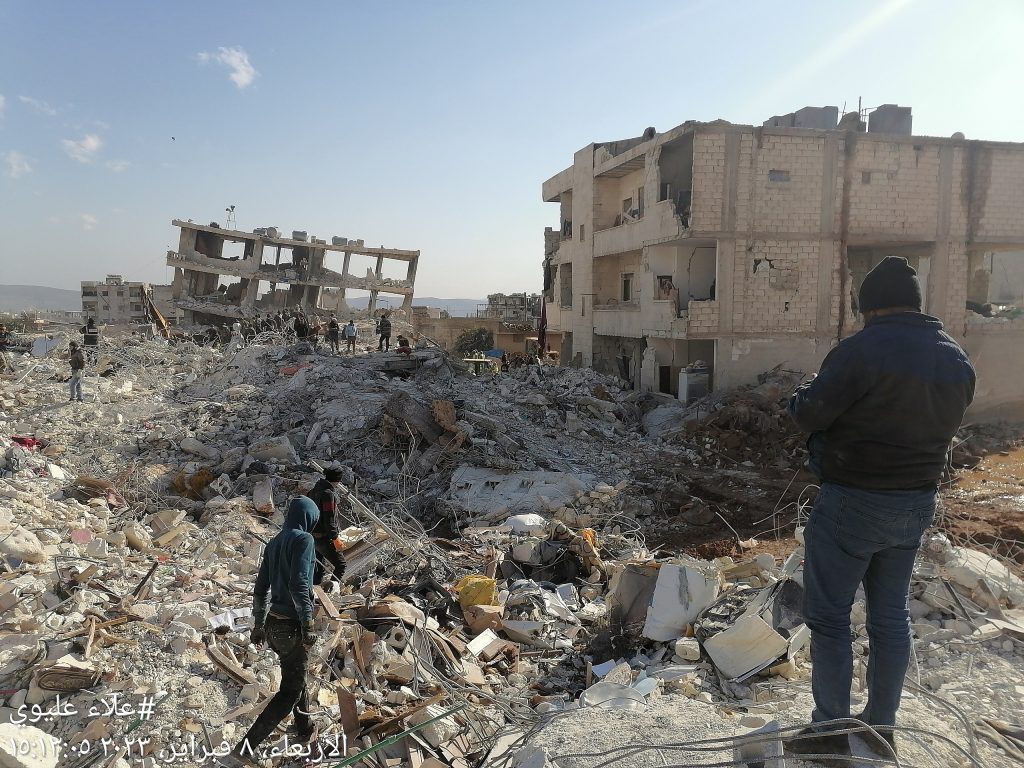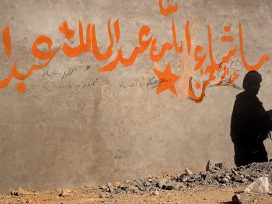The earthquakes of 6 and 7 February 2023 have piled further misery on a Syrian population that was already on its knees, largely made up of refugees from the war living in Turkey or displaced in north-west Syria. On the Syrian side of the border, particularly in the governorate of Idlib, it has been impossible to deliver the required emergency aid, whether supplied by the international community or the government itself. Isolated and abandoned, Syrians have had to rely on their own resources and organizations (such as the civilian White Helmets, originally set up to rescue the victims of bombings).
The international response has been able to reach the Turkish side to some extent, but it has been blocked from entering Syria by the extortion tactics of the regime, which is demanding total control over the distribution of humanitarian aid, including supplies allocated to the rebel-held areas that still lie outside its control. Under the guise of coordinating humanitarian aid, Bashar al-Assad is thus attempting to get his hands on a vital lifeline that he will hand out according to his own desires and interests, diverting a substantial part of it in the process, and turning it into an instrument for lifting sanctions and re-establishing his regional and international legitimacy.

Destruction caused by the earthquake of 6 and 7 February to the city of Afrin in northern Syria. Image: Alaa Ealyawi; source: Wikimedia Commons
This humanitarian trap seems to be working. The United Nations and the international community have been backed into a corner, gradually abandoning these regions and the displaced persons of Syria in the face of a cynical strategy of obstruction and instrumentalization of aid that the regime has been pursuing for years and which it had, with Russian support, notched up again early this year.
On 10 January 2023, a month before the disaster, United Nations Security Council resolution 2642 was set to expire. This resolution, passed in July 2022, authorized the last remaining delivery point for humanitarian aid to 4 million people in north-west Syria, almost half of whom live in refugee camps and are dependent on aid for more or less everything – water, food, heating and medical care.
Since 2019, Russia has used its veto on the Security Council to ruthlessly reduce the number of cross-border routes for this vital aid: a strategy so successful that aid can now only be delivered via Bab al-Hawa, on the Turkish border, using a cross-border mechanism that has to be extended by the Security Council every six months (rather than every twelve months as previously). Russia wanted to get rid of this last remaining aid corridor altogether – on the grounds that ‘the war is over’ – but it has recently conceded another six-month extension, in order to avoid overly irritating Erdoğan.
On 21 December 2022, Martin Griffiths, the UN Under-Secretary-General for Humanitarian Affairs and Emergency Relief Coordinator, spoke of an unprecedented economic and humanitarian crisis that was particularly acute in northern Syria, but was affecting the whole country, with 90 per cent of the population living below the poverty line, and 14.6 million people dependent on humanitarian aid (1.2 million more than the previous year).
The weaponization of humanitarian aid
The living, hygiene and sanitary conditions in the camps in north-west Syria have caused a resurgence of parasitic diseases and a worrying outbreak of cholera: as of 18 December 2022, one hundred deaths and 62,000 suspected cases of cholera had been reported. Two months earlier, Raphaël Pitti, the head of Mehad (a French NGO providing treatment to civilians, training for medical teams, and funding for health centres), noted that nearly 30 per cent of the cholera victims across Syria were under the age of five. The 322 health centres that are still operating (out of a previous 544) lack resources and drugs, and the health system is on the brink of collapse.
Under such circumstances, there can be no doubt about what the end of humanitarian aid would mean, and why Russia is so keen to bring this about: it would doom these people not only to a humanitarian disaster, but also to the violence of siege warfare, a deadly weapon that Bashar al-Assad has used over the past decade against every city or region that has escaped his control, subjecting populations to starvation and bombardment, and then forcing the survivors into exodus or submission. Now comes the turn of Idlib, which since 2019 has been the target of an intensive bombing campaign resulting in what the UN Emergency Relief Coordinator has described as ‘carnage’.
The politics of humanitarian aid, a residual area in which the w estern democracies’ demands at the UN have been restricted by the Russian veto, have thus been weaponized. Similarly, back in 2012, we saw media information being turned into a weapon of terror and a sign of impunity: since the images of slaughter did not lead to any outside interventions or deliveries of heavy weapons or air defence systems, they merely demonstrated the blank cheque given to the regime.
The shortfall in funding from the international community foreshadows a nightmare scenario: the 2022 Humanitarian Response Plan has received only 43 per cent of the funds required, and the 2022–2023 winterization response, required to meet the needs of 6 million people, was only 21 per cent funded. Behind these figures, a real war is still raging. On 21 December 2022, UN Special Envoy Geir O. Pedersen reminded the Security Council that the conflict in Syria was far from over, and that while the patchwork of bilateral agreements between Turkey, Russia and the United States had brought about a relative reduction in violence, the situation remained highly unstable.
The crisis of the Syrian state
Martin Griffiths of the UN highlighted the tragic records broken in 2022: 138 civilians killed and 249 injured in north-west Syria alone. According to the Syrian Network for Human Rights, across the country as a whole, 926 civilians were killed, including 232 children; 2,221 people were arrested and imprisoned, including 148 children; and the whereabouts of 111,000 disappeared persons remain unknown.
On 30 April 2022, the Syrian government announced the release of 539 detainees but did not provide a list of their names, prompting families to frantically search for their loved ones in the streets, with no help from the International Committee of the Red Cross, which was conspicuously absent. This gesture, aimed at the international community, only concerned a tiny fraction of the prison population. Syria continues to be ruled by a climate of fear, fuelled by arbitrary detentions and forced disappearances that have never relented, including in government-held areas (70 per cent of the country).
The Syrian state, which has been on life support for years, is now on the verge of collapse. In the areas under its control, the regime is persisting with its disastrous economic policies in a caricature of the neoliberalism of the 2000s. While households often have only a few minutes of electricity a day, and people are sometimes unable to go to work due to the cost of transport, a tiny minority continues to live in luxury. Various sordid kinds of business are flourishing, such as the production and distribution of the narcotic Captagon (an amphetamine), which is controlled by the Fourth Armoured Division of the army, commanded by Bashar’s younger brother Maher al-Assad. Syria is now the world’s leading exporter of this drug.
The everyday realities of rampant inflation, mass unemployment, and widespread corruption doom people of all political persuasions – including loyalists – to despair. Suicides are up, disguised as ‘heart attacks’, but sometimes anger wins out. In As-Suwayda, in the south of the country, protestors recently burned images of Bashar al-Assad and chanted anti-government slogans. As usual, the regime responded with a fierce crackdown.
In the north of Syria, rebellion is brewing for a different political reason: Erdoğan’s announcement of a rapprochement with Assad, which was confirmed on 28 December 2022 by a tripartite meeting in Moscow between the Russian, Syrian and Turkish defence ministers. Two days later, thousands of Syrians demonstrated in Al-Bab, a city controlled by pro-Turkish factions, and in several locations in Aleppo governorate, chanting ‘Don’t ally with Assad against us’ and ‘We’d rather die than reconcile with Assad’. A banner in Arabic, Russian and Turkish read: ‘Revolution is an idea, you can’t kill an idea’.
Failing the Syrian people
Turkey, meanwhile, continues to bomb Kurdish positions in the north-east and is threatening to launch a major ground offensive. It is thus making clear its desire to join the club of Arab governments that have normalized their diplomatic and trade relations, both direct and indirect, with Damascus. The West also appears resigned to the continued existence of Assad’s regime. Those calling for the normalization of relations do so in the name of ‘regional stability’, in the interests of civilians whose misery is made worse by sanctions, as a way to counter Russia and Iran’s grip over Syria.
This has been a resounding failure, as Russia and Iran have continued to strengthen their tactical partnership, turning it into an offensive military alliance in Ukraine, where Iran’s ‘Shahed’ (‘martyr’) combat drones have been used. In Israel, Benjamin Netanyahu was similarly mistaken in the belief that he could curb Iranian activity by supporting Russia. Vladimir Putin’s adventurism in Ukraine has turned the European Union and the United States against him, but he continues to exploit his Middle Eastern fiefdom for the purposes of his war.
In Turkey, Lebanon and Jordan, but also in Denmark, there is growing hostility towards Syrian refugees, who are being threatened with deportation orders that ignore the proven and documented continuation of persecution in their home country: Syria’s amnesty decree and its 2021 anti-torture law are purely for show, and those refugees who have returned have faced arrest and torture. It took action by French citizens to prevent the asylum claim of journalist Hussam Hammoud, who has worked to expose the crimes of Daesh in Raqqa, from being rejected in early 2002.
On 6 January 2023, the French authorities were accused by three NGOs – Amnesty International, La Cimade, and Revivre – of contacting the Syrian embassy in an attempt to deport two refugees back to Syria, despite Paris having broken off diplomatic relations with Damascus in March 2012, and the Geneva Convention prohibiting a person from being returned to a country where they are at risk of death or torture. Three months earlier, the two individuals had been illegally placed in a detention centre by the Haute-Garonne and the Paris Police prefectures.
French NGOs condemned these ‘scandalous and illegal’ attempts and urged the government to remind prefectures of France’s international obligations and commitments, which Manon Fillonneau, head of migration issues at Amnesty International, argued had been betrayed in this case by the ‘frantic quest to execute OQTFs’ (expulsion orders from French territory).
From Syria to Ukraine
No one now denies that Syria was the military and diplomatic testing ground for Putin’s offensive in Ukraine. But the Syrian story continues to take its own unique path, and we must continue to follow it and understand what it says about our world – and what it asks from it. The shock of the aggression against Ukraine has finally exposed the criminal nature of Russian intervention in Syria.
The confrontation between a desire for democracy and an autocratic will is now being played out on Ukrainian soil – militarily but also through the information and energy wars – and on other fronts, which may seem remote and separate but are in fact interconnected. They include a number of unstable regions in which latent conflicts threaten to ‘thaw’ or erupt, from Europe (between Serbia and Kosovo) to Africa (in Mali and the Central African Republic), and from Asia (between China and Taiwan) to the Middle East. In the Middle East, numerous tangled situations are unravelling or threatening to bubble over: in Syria, Lebanon, Palestine, Iraq, Iran and Turkey, to name but a few.
While the war in Ukraine has worsened the economic and humanitarian situation in Syria, it contains a kernel of hope for the Syrian people oppressed by the regime. Whatever happens in Ukraine will have major repercussions in the Middle East. Putin’s failure is likely to have positive consequences in Syria, where the wait for justice is linked to the prospect of trials for Russia’s ‘crimes of aggression’ against Ukraine.
The prosecution of Syrian criminals based on the principle of universal jurisdiction is a response to this hope, but it remains in its infancy and at present represents a barely perceptible dent in the edifice of enduring and powerful impunity. It was in Syria that Assad’s impunity for war crimes and crimes against humanity was put to the test and confirmed when the United States backed down from its ‘red line’ regarding the use of chemical weapons. And it was in the total war waged by Russia in Syria that Russia’s impunity was established.
Over the past decade, Syria has revealed our uncertainties and weaknesses when it comes to the dialectic between state terror and jihadist terrorism. Now it has become a symptom of our inability to take action on multiple fronts, to understand how they are connected, and – most crucially – to show solidarity and provide help to those who desperately need it, beyond geostrategic concerns.
In response to the disaster that is currently unfolding in Syria, where the situation can only get worse, we must seek out and identify forms of support that take into account what is really going on and what may happen in the future: a clear and firm welcome for political refugees and a categorical rejection of all deportations; material aid via the NGOs that still have a presence in the country and remain independent.
In the longer term, there needs to be support for subsistence farming, which is the only way to feed the population in an economy sapped by war profiteers; funding for research in the field of hydraulics in order to combat repeated droughts; and, finally, support for the archival work being done by groups of Syrian activists (including, in France, the Creative Memory of the Syrian Revolution) to keep alive the traces of the 2011 democratic uprising in the name of dignity and freedom.
The experience of Syrians, however tragic it may be, must be shared, discussed, transformed, and lived differently, even in exile, while they wait for this regime, an enemy of history consumed by death, to collapse and make way for life.

Published in cooperation with CAIRN International Edition, translated and edited by Cadenza Academic Translations.








